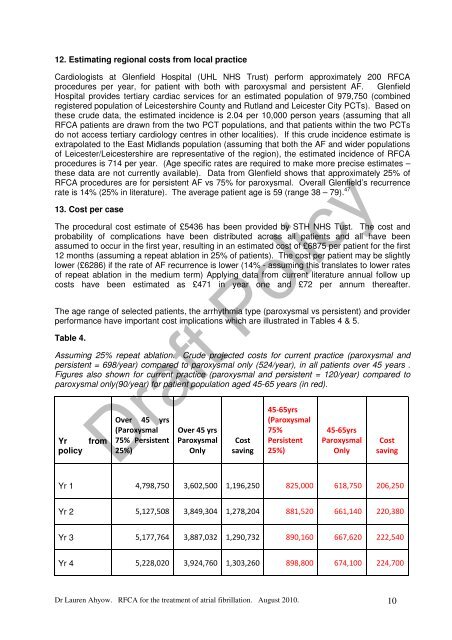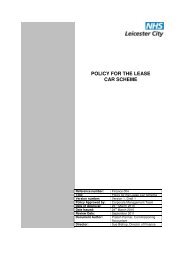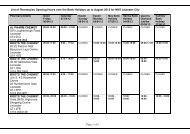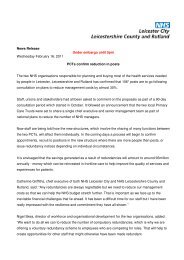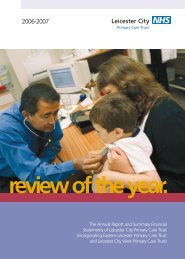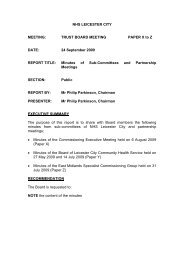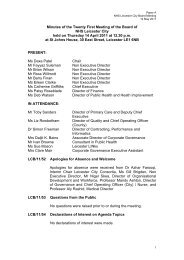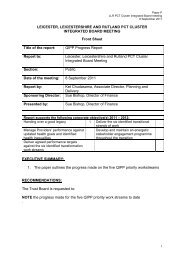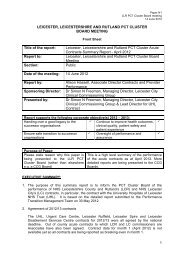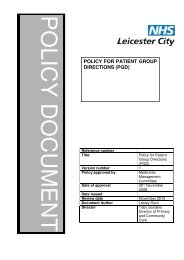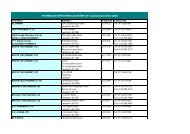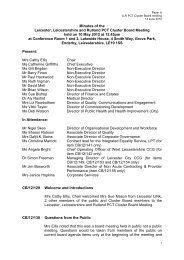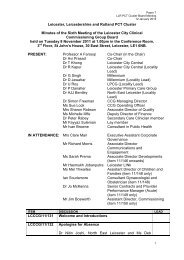Radiofrequency Catheter Ablation (RFCA) as second-line ... - NHS
Radiofrequency Catheter Ablation (RFCA) as second-line ... - NHS
Radiofrequency Catheter Ablation (RFCA) as second-line ... - NHS
Create successful ePaper yourself
Turn your PDF publications into a flip-book with our unique Google optimized e-Paper software.
12. Estimating regional costs from local practiceCardiologists at Glenfield Hospital (UHL <strong>NHS</strong> Trust) perform approximately 200 <strong>RFCA</strong>procedures per year, for patient with both with paroxysmal and persistent AF. GlenfieldHospital provides tertiary cardiac services for an estimated population of 979,750 (combinedregistered population of Leicestershire County and Rutland and Leicester City PCTs). B<strong>as</strong>ed onthese crude data, the estimated incidence is 2.04 per 10,000 person years (<strong>as</strong>suming that all<strong>RFCA</strong> patients are drawn from the two PCT populations, and that patients within the two PCTsdo not access tertiary cardiology centres in other localities). If this crude incidence estimate isextrapolated to the E<strong>as</strong>t Midlands population (<strong>as</strong>suming that both the AF and wider populationsof Leicester/Leicestershire are representative of the region), the estimated incidence of <strong>RFCA</strong>procedures is 714 per year. (Age specific rates are required to make more precise estimates –these data are not currently available). Data from Glenfield shows that approximately 25% of<strong>RFCA</strong> procedures are for persistent AF vs 75% for paroxysmal. Overall Glenfield’s recurrencerate is 14% (25% in literature). The average patient age is 59 (range 38 – 79). 4713. Cost per c<strong>as</strong>eThe procedural cost estimate of £5436 h<strong>as</strong> been provided by STH <strong>NHS</strong> Tust. The cost andprobability of complications have been distributed across all patients and all have been<strong>as</strong>sumed to occur in the first year, resulting in an estimated cost of £6875 per patient for the first12 months (<strong>as</strong>suming a repeat ablation in 25% of patients). The cost per patient may be slightlylower (£6286) if the rate of AF recurrence is lower (14% - <strong>as</strong>suming this translates to lower ratesof repeat ablation in the medium term) Applying data from current literature annual follow upcosts have been estimated <strong>as</strong> £471 in year one and £72 per annum thereafter.The age range of selected patients, the arrhythmia type (paroxysmal vs persistent) and providerperformance have important cost implications which are illustrated in Tables 4 & 5.Table 4.Assuming 25% repeat ablation. Crude projected costs for current practice (paroxysmal andpersistent = 698/year) compared to paroxysmal only (524/year), in all patients over 45 years .Figures also shown for current practice (paroxysmal and persistent = 120/year) compared toparoxysmal only(90/year) for patient population aged 45-65 years (in red).YrpolicyfromOver 45 yrs(Paroxysmal75% Persistent25%)Over 45 yrsParoxysmalOnlyCostsaving45-65yrs(Paroxysmal75%Persistent25%)45-65yrsParoxysmalOnlyCostsavingYr 1 4,798,750 3,602,500 1,196,250 825,000 618,750 206,250Yr 2 5,127,508 3,849,304 1,278,204 881,520 661,140 220,380Yr 3 5,177,764 3,887,032 1,290,732 890,160 667,620 222,540Yr 4 5,228,020 3,924,760 1,303,260 898,800 674,100 224,700Dr Lauren Ahyow. <strong>RFCA</strong> for the treatment of atrial fibrillation. August 2010. 10


